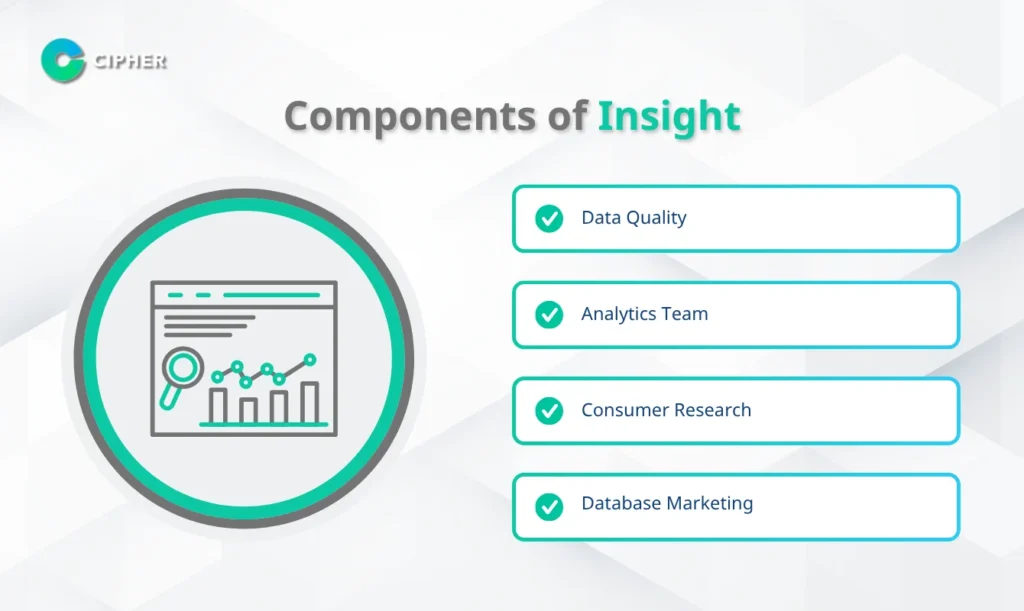Table of Contents
Defining Insight

Components of Insight

To obtain valuable Insights, several key components must come together. These include:
- Data Quality: The data used for analysis must be accurate, complete, and up-to-date.
- Analytics Team: Skilled data analysts are crucial for effectively collecting, analyzing, and interpreting data.
- Consumer Research: Conducting in-depth research to gather insights into consumer behavior and preferences.
- Database Marketing: Building a robust database to store and utilize consumer data for targeted marketing efforts.
Methods for Obtaining Customer Insights
1. Data Collection
2. Target Audience Research
3. Data Analysis
4. Building a Marketing Database
Insight vs. Fact: What's the Difference?
Insight
Fact
Benefits of Consumer Insights
Examples of Customer Insight Analysis
Starbucks
Netflix
Netflix leverages insights from user viewing behavior, such as preferred content genres, viewing times, and devices used. They analyze this data to understand the interests and lifestyles of different viewer segments. These insights inform the creation of original content (Netflix Originals) and the development of personalized content recommendation systems, keeping users engaged and subscribed to their streaming service worldwide.
Unlock the Power of Insight with Cipher's Services
Cipher, a leading company specializing in Insight analysis and Insight Marketing, offers expert marketing consulting services to help businesses harness the power of Insight. With a team of skilled data analysts and cutting-edge technology, Cipher assists clients in collecting, analyzing, and extracting valuable Insights to inform marketing strategies, product development, and customer experience design. If you’re ready to unlock the potential of Insight, contact Cipher today.
Summary
Insight forms the foundation for creating marketing strategies that effectively address customer needs and deliver value. By understanding and leveraging Insight appropriately, businesses can move forward with confidence and sustainability. If you want to enhance your competitive edge using the power of Insight but don’t know where to start, Cipher’s Insight analysis services are here to help you gain a deep understanding of your customers and utilize that knowledge effectively. Contact Cipher today to unlock the potential of Insight.
Frequently Asked Questions
What is Insight?
Insight refers to a profound understanding of consumers, derived from analyzing and interpreting data to uncover the true causes behind their behavior, attitudes, and desires. Insights go beyond surface-level data and can be applied to develop marketing strategies, improve products and services, and enhance the customer experience.
What are Business Insights?
What are the key components of Insight?
Effective Insights rely on several essential components:
- Data Quality: The data used for analysis must be accurate, complete, and current.
- Data Analysis Skills: The ability of data analysts to collect, process, and interpret data.
- Understanding of Consumer Behavior: Knowledge of consumer behavior and the factors influencing it.
- Integration of Multiple Data Dimensions: Combining quantitative and qualitative data from various sources.
- Ability to Apply Insights: The capacity to translate Insights into actionable strategies benefiting the business.
What can Customer Insights be derived from?
Key sources of data for deriving Customer Insights include:
- Demographic Data: Information such as gender, age, location, income, etc.
- Purchase and Product Usage Behavior: Frequency, value, timing of purchases, and product usage.
- Response to Marketing Campaigns and Brand Communication: Engagement with marketing efforts and brand messaging.
- Market Research Data: Surveys, in-depth interviews, focus group discussions.
- Voice of Customer: Feedback from customer service interactions, including compliments, complaints, and suggestions.
- Website and App Usage Data: User behavior on digital platforms.
- Social Media Conversations and Interactions: Customer discussions and engagement on social media channels.





